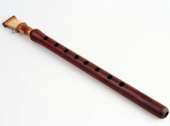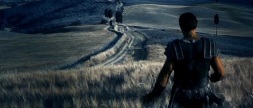To commence this musical journey, I will consider this brilliant piece from the sound track of the movie Gladiator: ‘Now we are free’
 The movie is set in the Roman war era and has an aesthetic backdrop of afterlife to it. It’s about an immensely valiant warrior who is waiting to achieve his purpose in life, his vengeance, before transcending to heaven, to be one with his family. This piece tries to capture exactly this moment when his purpose in life is fulfilled and he is now free. It beautifully balances the gravity of the warrior’s last war with the spirit of heaven.
The movie is set in the Roman war era and has an aesthetic backdrop of afterlife to it. It’s about an immensely valiant warrior who is waiting to achieve his purpose in life, his vengeance, before transcending to heaven, to be one with his family. This piece tries to capture exactly this moment when his purpose in life is fulfilled and he is now free. It beautifully balances the gravity of the warrior’s last war with the spirit of heaven.
The piece begins with a marching rhythm and a mellow chord progression sets the mood. Lisa Gerrard’s haunting vocals kick in and a beautiful echo effect embellishes the vocals. Fast paced lyrics come in later, as if to signify the calling from heaven. Towards the end, the percussion stops and the soothing vocals bring in the effect of a final goodbye and calm that permeates after that.
Impact:
This track by the composer Hans Zimmer is definitely a pioneering work. Not only has this track attained the popularity levels of the music of Titanic or Star Wars, but it has also been critically acclaimed for being in perfect tune with the vision of the film. Hans Zimmer bagged the Oscar for Best Original Music Score for the film and several other awards as well. This piece showcases that being creative is not sufficient for a film composer, he also has to be meticulous and methodical in many ways. Hans Zimmer set a trend for all ancient war movies that followed.
Instrumental Arrangement:
 The piece of course uses traditional orchestral elements like chord progressions with pianos and cellos. Also, the rhythm is heavily influenced from classical Viennese waltz structure. Apart from this, Zimmer also uses some indigenous instruments like Duduk (a flute-like instrument from Armenia) to give harmony and some African percussion instruments.
The piece of course uses traditional orchestral elements like chord progressions with pianos and cellos. Also, the rhythm is heavily influenced from classical Viennese waltz structure. Apart from this, Zimmer also uses some indigenous instruments like Duduk (a flute-like instrument from Armenia) to give harmony and some African percussion instruments.
Vocals:
Typically, chants are the ancient prayers that used to be sung (are occasionally sung even today) in churches. The vocals are loosely influenced from German choral chants. This helps to bring about the effect of the Roman era. Heightened vocals have also been used occasionally to create harmony and a contrast effect. Lisa Gerrard fills the silhouette created by the instruments with wonderful precision of her vocals.
Lyrics:
The lyrics do not mean anything, whatsoever. Lisa Gerrard has sung the piece in a language she herself has created, a language in which she used to communicate with God since the time she was very young. Some people claim that few of the words sound like Hebrew and there are translated versions of the lyrics as well. (It’s indeed surprising how people can translate words from a language that does not exist !!) But the fact remains that the lyrics are just made-up. An advanced version of singing la-la-la or na-na-na, I would say..
 All in all, this piece as a whole aesthetically captures the world of Rome as well as the glimpses of afterlife that garnish the movie. It always gives me a feeling of great hope, combined with inner peace when I listen to it. Hope you all enjoy the piece as well 🙂
All in all, this piece as a whole aesthetically captures the world of Rome as well as the glimpses of afterlife that garnish the movie. It always gives me a feeling of great hope, combined with inner peace when I listen to it. Hope you all enjoy the piece as well 🙂
PS: I sincerely recommend you to watch the movie Gladiator if you haven’t already watched it. Of course the movie is brilliant, but if not for the movie then to better appreciate the music in context of the movie !!
For the more interested listener…
- Viennese waltz: Waltz is a traditional form of ball room dancing with elegant rotations and musically, it is a piece with ¾ beat signature composed typically for a ball room dance events. We have all heard the beautiful ‘Waltz for Romance’ by A.R.Rahman in Lagaan. This waltz is highly acclaimed in the western community as well.
Viennese waltz is considered as the original form of waltz with a relatively slow pace. This is a piece of Viennese waltz that I found nice. (Somehow it reminds me of the bollywood song raja ko rani se pyaar ho gaya !!)
- Chants: It is believed that western classical music began with plainchant (also called Gregorian chant), which were the vocal religious practice of the Roman Catholic Church. Plainchant was transmitted by memory until the early 9th century after which some documentation of the same is found. This is a famous Gregorian chant sung even today.
Initially, the chants were limited in pitch range and were monophonic. The melodies have striking similarities with the melodies of ancient shlokas of Rigvedas. It’s an amazing coincidence that the melody of prayers evolved independently for the Church and for the Hindu temples share such similarities !!